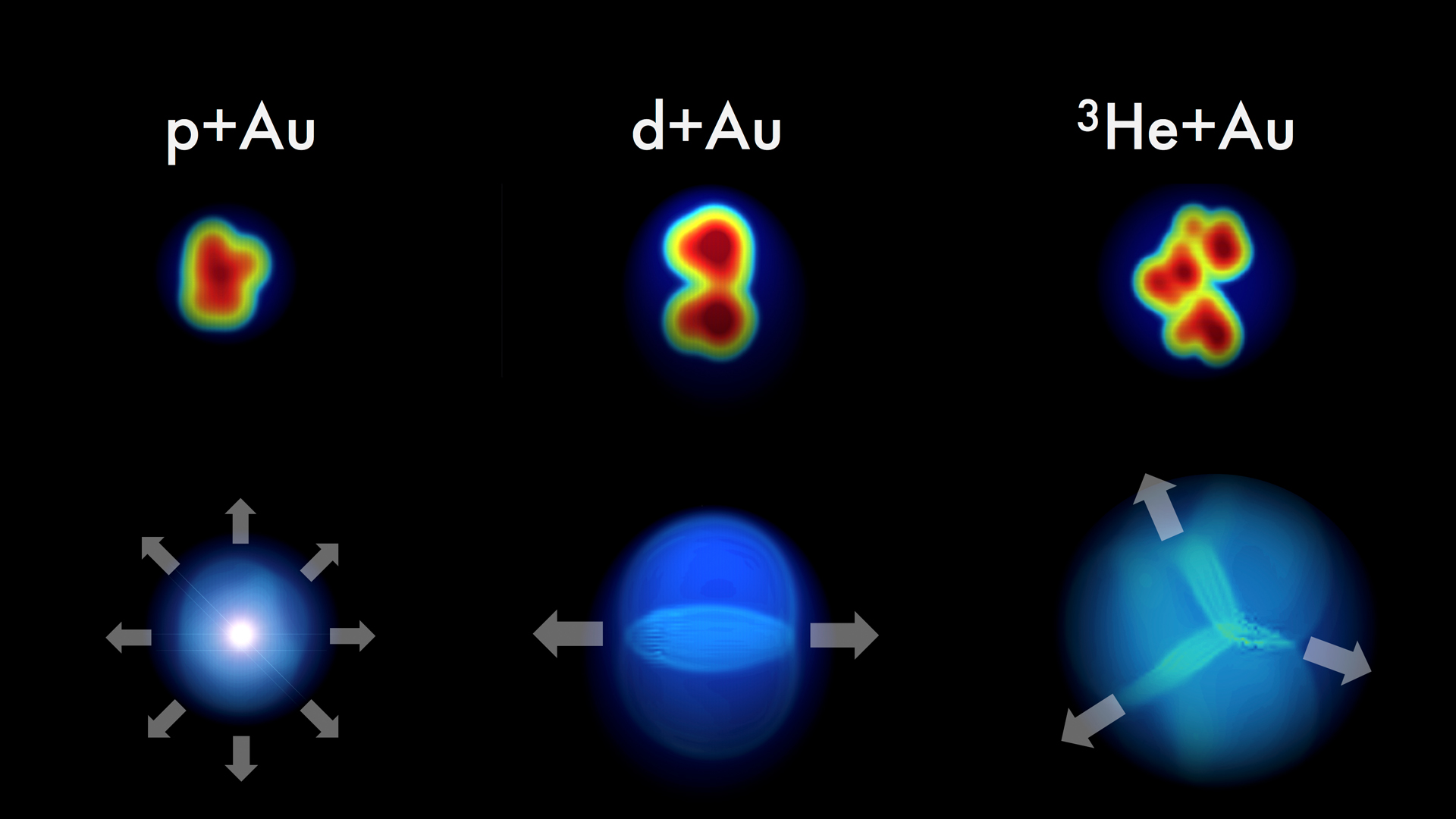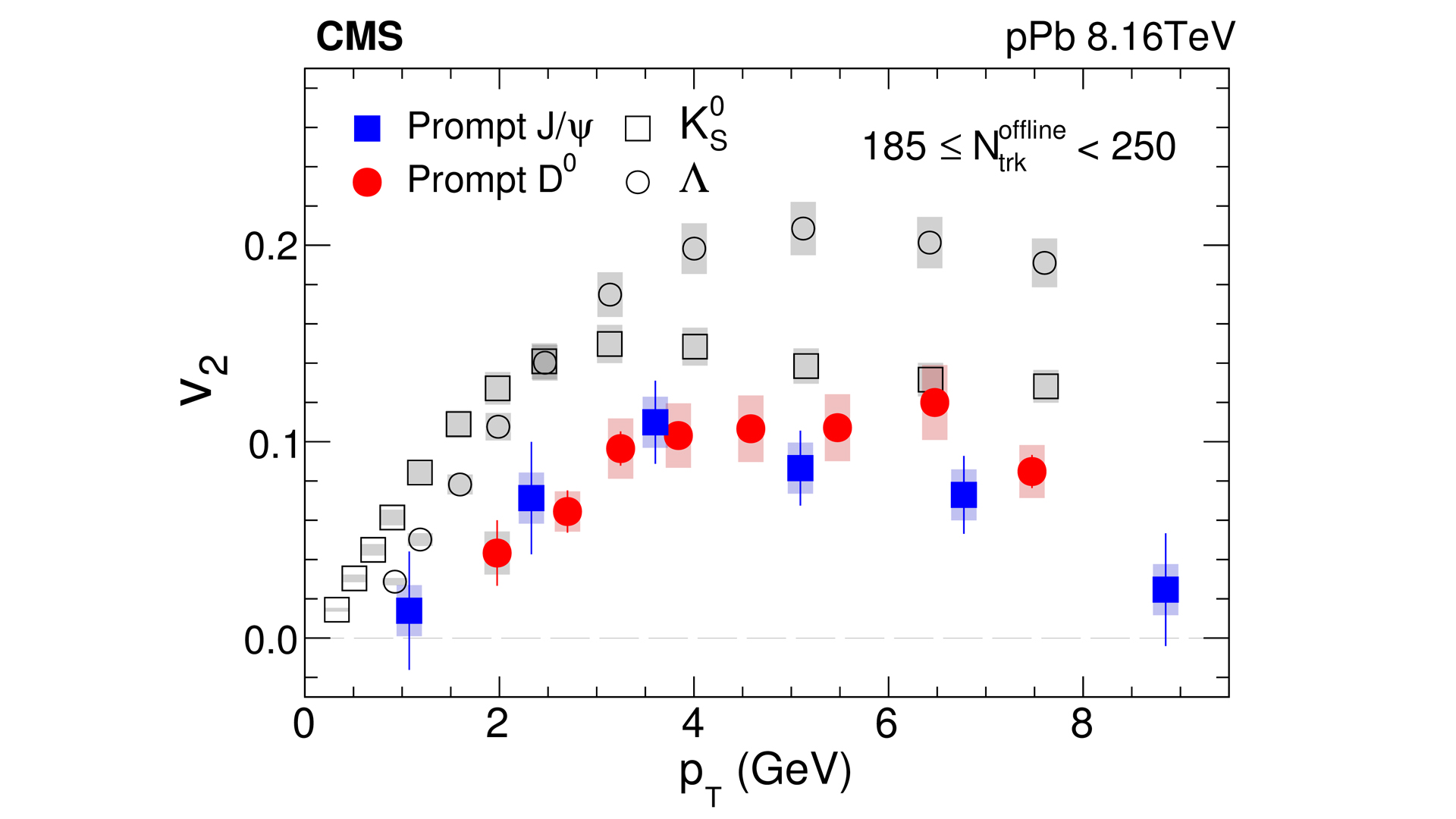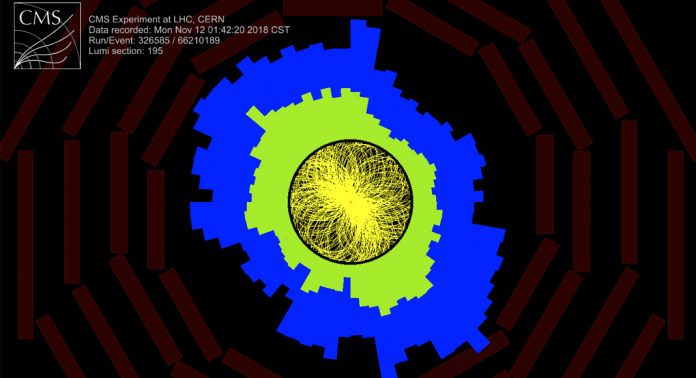By investigating the world’s smallest droplets of near-perfect fluid, researchers have been able to develop greater understanding of the primordial matter in the Universe.
A collision between two atomic nuclei accelerated to a significant fraction of the speed of light can produce a primordial state of matter such as existed microseconds after the Big Bang. During the collision, the nuclei melt into a hot, dense fluid consisting of deconfined quarks and gluons. This state of matter, called the quark-gluon plasma (QGP), is the hottest and densest matter ever produced in the laboratory. A cubic centimetre would weigh 40 billion tons, and the temperature is 100,000 times hotter than the centre of the Sun.
The QGP has the properties of a nearly perfect fluid with an extremely low ratio of shear viscosity to entropy density. Because of its low viscosity, the QGP can also sustain vorticity, swirling at a high rate of speed indefinitely. After about 10-23 seconds, the QGP expands and cools, hadronizing into normal matter where the quarks exist in mesons and baryons, the quark bound states. The particles resulting from this process, as well as decay products, stream into the particle detectors, where their physical properties can be measured. The QGP is produced and studied at the Relativistic Heavy Ion Collider (RHIC) at Brookhaven National Laboratory in New York and at the Large Hadron Collider (LHC) at CERN in Geneva.
Collective flow in large systems
When the heavy nuclei collide off-centre, the initial overlap zone has an approximately ellipsoid shape, and an enormous amount of energy is packed into that tiny space. Because the initial shape is not spatially symmetric, the pressure in the droplet is more efficient in pushing the liquid out of the collision zone along the short axis of the ellipsoid, rather than perpendicular to it. As the temperature falls, and hadronization occurs, thousands of particles per collision can reach our detectors. An analysis of the azimuthal angle distributions of these particles reveals that they are not distributed evenly in every direction.
Figure 1 shows the signals observed in a single lead-lead collision by the CMS experiment. The yellow lines are the reconstructed charged-particle trajectories, and the green and blue shaded areas show the energy deposited in the electromagnetic and hadronic calorimeters, respectively. This event has a pronounced elliptical shape that is understood to be a consequence of the strong interactions in the QGP droplet, which induce collective flow of the produced particles. Theoretically, the evolution of the system can be described using relativistic viscous hydrodynamics, and the strong coupling implies that the fluid has very low specific viscosity. In the event that the system behaves as a gas of weakly interacting particles, the expansion would quickly become isotropic, and any memory of the initial-state spatial anisotropy would be erased.
Our group has been studying the QGP fluid for nearly two decades using data from the PHENIX experiment at RHIC and the CMS experiment at the LHC. There are many different ways to analyse the correlations between the particles that emerge in the final state, e.g., measuring the Fourier components of the particles’ azimuthal distributions or sorting the particles according to their transverse momenta, mass, or their quark content.
Although the nuclear impact parameter cannot be directly measured, collisions with differing initial nuclear overlap, which produce different initial pressure gradients, can be selected experimentally. Having access to two world-class experimental facilities provides additional opportunities to vary the energy or the size the colliding nuclei.
Over the years, a comprehensive set of measurements involving collisions of heavy ions, such as lead or gold, have been performed and the near-perfect fluid description has become well-established1. Although the QGP produced at the LHC is hotter and longer lived than the QGP at RHIC, the fluid properties are very similar: the produced particles are globally correlated with the initial geometry of the collisions and their event-by-event fluctuations, the flow appears to arise at the partonic level, since its strength scales with the number of quarks in the produced hadrons, and the specific shear and bulk viscosities extracted from state-of-the-art data-to-theory comparisons are indeed remarkably low2 (of the order 0.1).
Collectivity in small systems
When LHC collided protons with lead ions for the first time, it was surprising that strong particle correlations were also present in the collisions that produced a large number of particles. The initial motivation to study proton-lead collisions was to perform a control experiment where no hot QGP is expected to be formed, and therefore any initial-state effects associated with the presence of cold nuclear matter in the lead nucleus could be isolated.
The results proved to be much more interesting and challenging to interpret than anticipated, giving rise to a number of questions: When does the QGP turn off? What is the smallest liquid droplet that can evolve hydrodynamically? Is it still a near-perfect fluid? Does the system need to be in local thermal equilibrium for hydrodynamics to be applicable? To answer some of these questions, we explored the most prominent feature in the fluid behaviour – the ability to retain a “memory” of the initial geometry through the pressure gradients that drive the flow. In a proton-lead collision, anisotropic initial spatial distributions might be generated by quantum fluctuations in the proton projectile and by the event-by-event fluctuations of the locations of protons and neutrons that make up the lead nucleus.
However, if instead of a single proton we bombard a large nucleus with a deuteron (a bound state of a proton and a neutron), or a helium-3 nucleus (two protons and a neutron), then the initial hot zones will have distinct geometric shapes. These geometry-engineered experiments were carried out at RHIC. A visualisation of the initial hot spots and the final-state particle flow patterns predicted for a near-perfect fluid expansion are shown in Figure 2.

Using PHENIX data, we measured3 the elliptic and triangular anisotropies in the azimuthal distributions of the particles emerging from the three collision systems. The six measured flow patterns match the hydrodynamic prediction quite well, while alternative explanations invoking initial-state momentum correlations4 originating from a novel gluonic state of matter have thus far been unable to describe the six measurements simultaneously. This gives strong support for the hypothesis that small droplets of QGP are formed in the collisions. Within the last few years, most signatures of QGP formation in large systems have been also observed in small collisions systems, even including proton-proton collisions, yet the quest for understanding how this near-perfect fluid behaviour emerges from the underlying quark and gluon interactions continues.
Heavy quark puzzles
Because of their large masses, heavy quarks (charm and beauty) are primarily produced via hard-scattering processes at a very early stage of the collision. Once produced, they cannot be destroyed by interactions with the soft gluons and light-flavour quarks making up the bulk of the QGP droplets. Therefore, they can be used to probe the QGP properties. In large collision systems, both RHIC and LHC measurements show that D0 particles carrying open heavy flavour (e.g., a charm quark is paired with a light anti-quark) have strong elliptic flow patterns, similar to other particles emerging from the QGP droplets. This suggests that, despite their large mass, the charm quarks may be caught up in the flow.
In lead-lead collisions at the LHC, where the QGP is longer-lived and the charm quarks are produced in abundance, large elliptic flow has also been observed in J/ψ mesons, which are bound states of charm and anti-charm. This provides further evidence for the collective behaviour of charm quarks in the QGP.
However, QGP produced in small systems is short-lived, and it is much harder for the charm quarks to equilibrate with the medium. Still, a recent CMS analysis of high-multiplicity proton-lead collisions discovered5 significant flow signals in J/ψ mesons. Figure 3 shows that the J/ψ and D0 elliptic flow amplitudes are comparable, and only slightly smaller than those observed for particles carrying lighter quarks. This poses the question as to how such strong flow can be induced in J/ψ mesons during the short lifespan of a tiny QGP droplet. In large systems, the J/ψ mesons might be dissolved by the coloured medium, and then re-formed from charm and anti-charm quarks that have been swept by the flow of the bulk system. This mechanism is less likely in the short-lived smaller systems. A possible alternative is that the J/ψ flow originates in the initial state, where multi-gluon production from a saturated gluonic medium leads to long-range correlations.

To test the different hypotheses, a comprehensive study of the collective flow of charm and beauty quarks, and the J/ψ mesons in different systems that have different initial states, temperature, and lifetimes is needed. If initial state correlations are dominant in proton-lead collisions at the LHC, then these correlations should also be present in proton-proton collisions at LHC energies, and in other small systems measured at RHIC. To establish the role of charm quark-antiquark coalescence and the heavy quark equilibration in large-system QGP at RHIC, we are in the process of analysing 30 billion gold-gold collision events collected by PHENIX. With these data sets, we expect to obtain statistically significant measurements of J/ψ, and separated charm and beauty flow. The study of J/ψ flow in proton-proton collisions at the LHC will provide additional constraints to determining initial- versus final-state effects.
The study of the world’s smallest droplets of near-perfect fluid has given rise to significant experimental and theoretical developments, deepening our understanding of strongly interacting systems, the description of the wave function of the incident nuclei, pre-equilibrium dynamics, hydrodynamic evolution, and how the correlations between the observed final-state particles can be used to extract quantitative constraints on the properties of the produced medium. While our understanding continues to evolve, studying these systems can be a significant step towards deciphering how complex self-organised systems emerge at these scales.
Acknowledgements
This work was supported in part by the Office of Nuclear Physics in the DOE Office of Science.
References
- Ulrich Heinz (Ohio State U.), Raimond Snellings (Utrecht U.) Collective flow and viscosity in relativistic heavy-ion collisions, Ann. Rev. Nucl. Part. Sci. 63 (2013), 123-151, DOI: 10.1146/annurev-nucl-102212-170540
- JETSCAPE Collaboration, D. Everett (Ohio State U.) et al. Multi-system Bayesian constraints on the transport coefficients of QCD matter, Phys. Rev. C 103 (2021), 054904, DOI: 10.1103/PhysRevC.103.054904
- PHENIX Collaboration., Aidala, C., Akiba, Y. et al. Creation of quark–gluon plasma droplets with three distinct geometries. Nat. Phys. 15, 214–220 (2019). https://doi.org/10.1038/s41567-018-0360-0
- Kevin Dusling and Raju Venugopalan Comparison of the color glass condensate to dihadron correlations in proton-proton and proton-nucleus collisions, Phys. Rev. D 87 (2013), 094034
- CMS Collaboration, Albert M Sirunyan (Yerevan Phys. Inst.) et al. Observation of prompt J/ψ meson elliptic flow in high-multiplicity pPb collisions at √sNN = 8.16 TeV, Phys. Lett. B 791 (2019), 172-194, DOI:10.1016/j.physletb.2019.02.018
Author Details
Julia Velkovska
Cornelius Vanderbilt Professor of Physics
+1 615 322 0656
Senta Victoria Greene
Stevenson Professor of Physics
+1 615 343 0657








